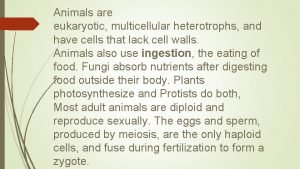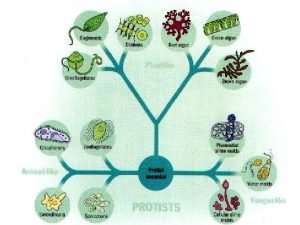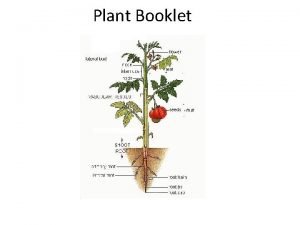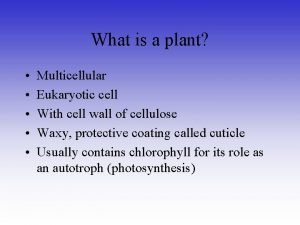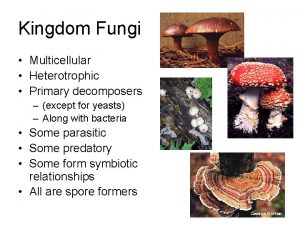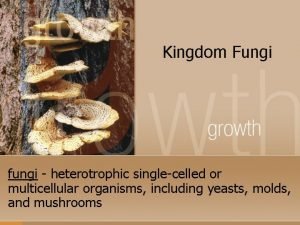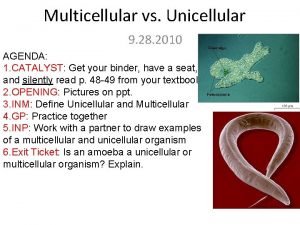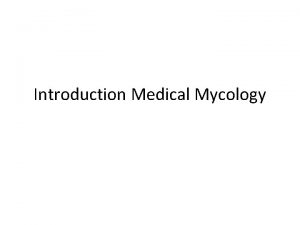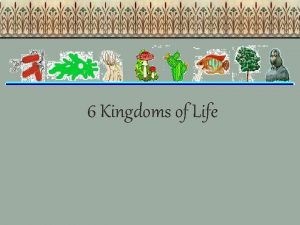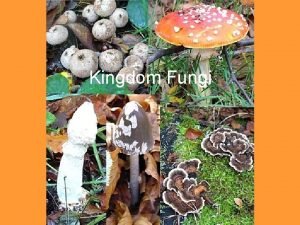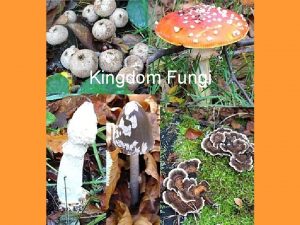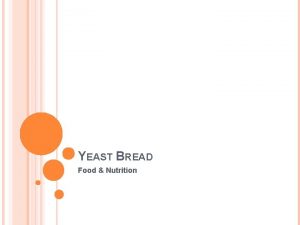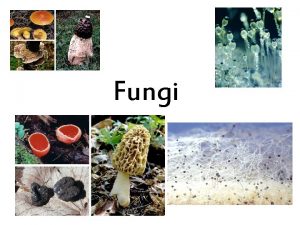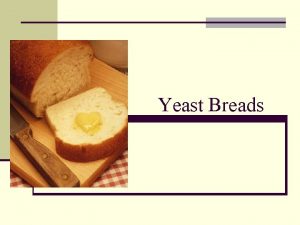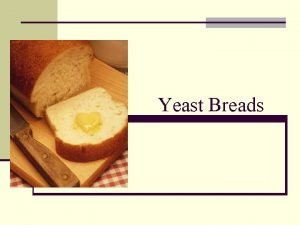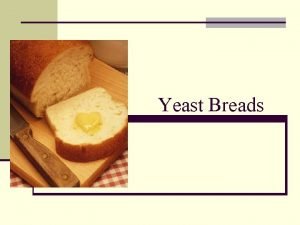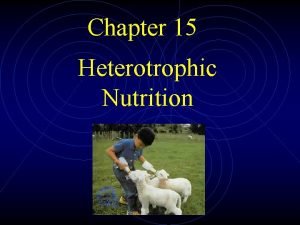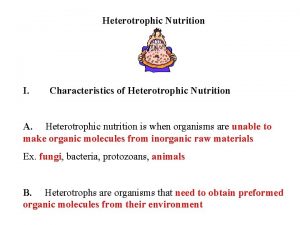Eukaryotes Multicellular except yeast Heterotrophic digest food outside



















- Slides: 19


� Eukaryotes � Multicellular (except yeast) � Heterotrophic – digest food outside of body and then absorb it �Some � Cell are parasitic walls made of chitin, a complex carbohydrate


� Composed of hyphae which are only one cell thick � Bodies of fungi are composed of masses of tangled hyphae called mycelium � The mycelium is well suited to absorb food because it permits a large surface area to come in contact with the food source through which it grows � Fruiting body is a reproductive structure that grows from the mycelium in the soil beneath it multiple mushrooms may grow from the same mycelium making it one organism � The fungus you see above ground is actually the fruiting bodies.

Hyphae are the individual threads, while mycelium is all of the hyphae put together.

�Both asexual and sexual �Asexual reproduction takes place in two ways � Cells or hyphae break off and grow into a new organism �Production of spores Produced in sporangia found at the tips of specialized hyphae called sporangiophores

�Sexual reproduction involves two different mating types: + and - (plus and minus) �When hyphae of opposite mating types meet, they start sexual reproduction by fusing and bringing the 2 nuclei together �After a period of growth, the nuclei form a zygote move into meiosis produces haploid spores which are released and develop into new organisms

� Found almost everywhere � Spores are released by fungus and are scattered by wind � Spores must land in a favorable environment proper combination of temperature, moisture, and food � SPORES AND BACTERIA ARE NOT THE SAME THING!!!!!

� � There are 4 phyla of fungi Zygomycota (Common Molds) Ex - Rhizopus stolonifer (black bread mold) � Asexual – spores in sporangiophores � Sexual – fusion of gametangia resulting in zygospores �


� Ascomycota �Ex (Sac Fungi) – Cup Fungi, Yeasts, Truffles, Neurospora (red bread mold) �Asexual – conidia on conidiaphores �Sexual – fusion of hyphae resulting in ascospores in ascus




� Basidiomycota �Ex (Club Fungi) – mushrooms, puffballs, bracket fungi �Asexual – none or conidia on conidophores �Sexual – fusion of cells on hyphae resulting in basidiospores on a basidium




� Deuteromycota (Imperfect Fungi) �Ex – penicillium, athletes foot �Asexual – Conidia on conidiophores �Sexual - none Penicillium
 Multicellular heterotrophs
Multicellular heterotrophs Are protists polyphyletic
Are protists polyphyletic Is protista autotrophic or heterotrophic
Is protista autotrophic or heterotrophic Are cell walls prokaryotic or eukaryotic
Are cell walls prokaryotic or eukaryotic Plants are multicellular eukaryotes
Plants are multicellular eukaryotes Plants are multicellular eukaryotes
Plants are multicellular eukaryotes Are plants multicellular eukaryotes
Are plants multicellular eukaryotes Multicellular organisms pictures
Multicellular organisms pictures Eutherian mammals
Eutherian mammals Multicellular heterotrophs
Multicellular heterotrophs Is the kingdom fungi multicellular or unicellular
Is the kingdom fungi multicellular or unicellular Is yeast multicellular or unicellular
Is yeast multicellular or unicellular Yeast unicellular or multicellular
Yeast unicellular or multicellular 6 kingdoms of life
6 kingdoms of life Fungi
Fungi Unit 2 food food food
Unit 2 food food food Food chain food chain food chain
Food chain food chain food chain Nebcutter
Nebcutter Visual field digest
Visual field digest Job search digest
Job search digest
